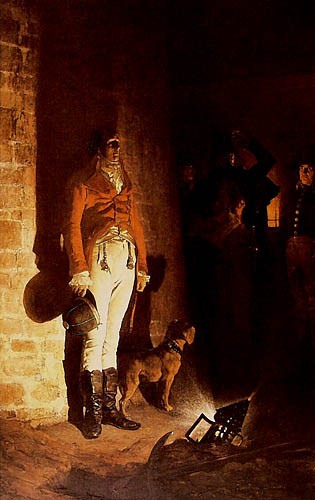It was simply by dint of his remarkable artistic talents that Jean-Paul Laurens, scion of a peasant family from Fourquevaux in the Haute-Garonne, managed to get himself accepted at the Toulouse Ecole des Beaux-Arts de Toulouse. On the strength of this, he received a bursary from the town which enabled him in 1860 to join the atelier Léon Coignet in Paris. Whilst his early years as a painter during the Second Empire were difficult – he was one of the Refusés of the Salon of 1863 -, his first triumph came at the Salon of 1872 when he received a Médaille de première classe for two paintings, The execution of the Duc d'Enghien and The Pope Formosus and Stephen VII. Considered by his contemporaries as one of the last history painters, the artist was to be lionised during the Third Republic when he was commisioned to provide the monumental decoration for several exceedingly high-profile public buildings, notably the Panthéon in Paris and the Capitole in Toulouse.
As a republican dyed in the spirit of 1848, Laurens was a painter of conviction whose works were often ideologically charged. At the Salon of 1872, Théophile Gauthier had welcomed him as “an artist whose works often exerted a strong emotional effect upon the public, […] his paintings are dark and full of energy; it is impossible not to remain motionless before them for long periods, regardless of the horror of the subject matter, perhaps even because of it”. A painting of the death of the Duc d'Enghien could not be politically innocent. It is true that the subject allowed Laurens to indulge in themes which marked the whole of his output – indeed one could almost say that, death, power, and the tragedy of existence were his obsessions. But here the artist is also denouncing regimes which wield power arbitrarily. By stigmatising one of the events which so overshadowed Napoleon I's accession to the throne, that is, the summary execution of the last Prince de Condé, Laurens sets himself within the anti-imperial trend which flowed from the war of 1870 and the fall of the Second Empire. Despite the fact that the painting exhibited at the Salon of 1872, which showed the reading of the sentence to the soon-to-be-executed Duke, was considered a State acquisition, it was apparently sold to an american art dealer. So Laurens painted a second version depicting the execution – a night scene (20 to 21 March, 1804), in the macabre setting of the dry moat of the Château de Vincennes, a moment of tragedy, where a young man is shot after a parody of a trial. The narrow framing, the single source of light casting a huge shadow on the wall, and the dog Mohilof, which was to howl itself to death over the tomb into which his master's body was thrown, all combine to dramatise the instant, set against the dignity and courage of the condemned man whose last words were: “How appalling it is to die at the hands of the French… “.
Karine Huguenaud (tr. P.H.)
May 2004
The execution of the Duc d’Enghien
Artist(s) : LAURENS Jean-Paul

- Date :
- 1872
- Technique :
- oil on canvas
- Dimensions :
- H = 1.65 m, L = 1.04 m
- Place held :
- Alençon, Musée des Beaux-Arts
- Photo credit :
- © DR.

